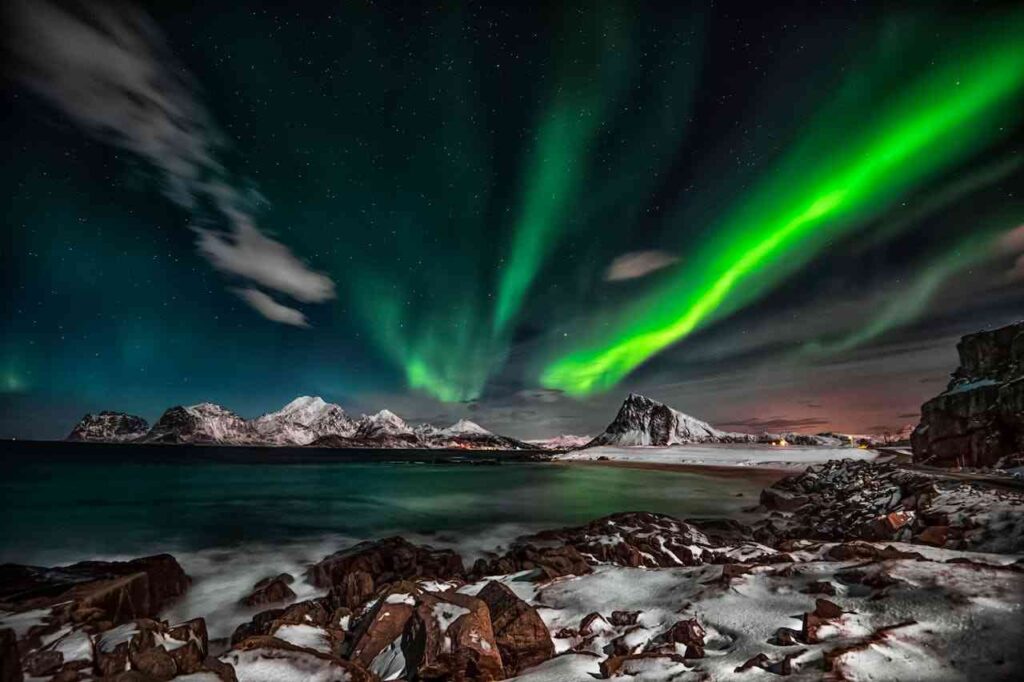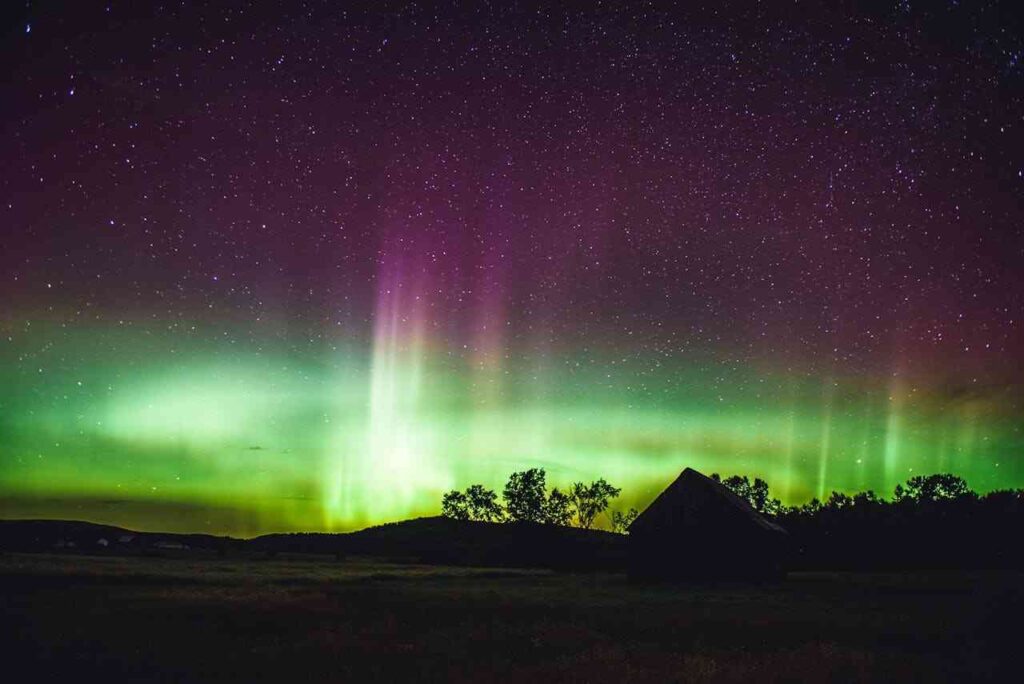If you are a fan of the Aurora Lights a rare once-in-11-years event is coming in March. In March, you have a great opportunity to see the pretty colors in the night sky shine brighter than ever. This happens because particles from the sun’s flares interact with the earth’s air and create these lights at the north and south poles.
A professor named Bill Wolf says that in March, when the sun and earth are in a special position, it makes the lights even more likely to happen. So, March is a fantastic time to look up and enjoy the sky lighting up at night!
This year due to high Solar Cycle 25 activity and bright sunspots, the Northern Lights will be brighter and can be seen in new places. Fortunately for travelers, we are on the brink of another solar maximum expected around 2024-2025. If you’re making plans now, it’s an ideal time to organize an exciting aurora hunting expedition.
In 1619, Galileo coined the term “aurora borealis” i.e. Northern Aurora. He blended the Roman goddess name associated with dawn, Aurora, with the Greek designation for the north wind, Boreas. If you’re in the United States, great spots to see the Northern Lights are Fairbanks, Alaska; northern Maine; Michigan’s Upper Peninsula; and northern Minnesota.
What is Aurora?

An aurora is a beautiful natural light show in the sky. Imagine colors like blue, red, yellow, green, and orange dancing gently and changing shapes. These magical lights only come out at night. You can usually spot them in the cooler parts of the world.
Auroras happen when speedy particles from the sun (electrons and protons in the solar wind) meet atoms in the upper part of the air. This interaction mainly occurs in specific areas around Earth’s magnetic poles, forming oval shapes. These zones stay in nearly the same position relative to the Sun.
When the Sun is less active, these aurora zones move closer to the poles. During active times, they can be seen farther from the poles, even reaching middle latitudes. For instance, the northern lights have been observed as far south as 40° latitude in the United States during high solar activity. The lights usually occur around 100 km (60 miles) above the Earth, but they can happen anywhere between 80 and 250 km (about 50 to 155 miles) above the surface.
If you head near the Arctic and Antarctic Circles, which are about 66.5 degrees north and south of the Equator, you might catch a glimpse of these dazzling lights almost every night. Up in the north, they call it aurora borealis, or northern lights, and down south, it’s called aurora australis, or southern lights. It’s like a colourful bedtime story the sky tells us on specific nights!
What is Solar Cycle 25?
The Sun has a magnetic field that goes through a repeating pattern called the solar cycle, which takes about 11 years. During this time, the Sun’s north and south poles switch places, and it takes another 11 years for them to switch back. Sunspots, which are dark spots on the Sun, increase and decrease in a cycle lasting around 11 years.
Since 1749, we’ve seen 23 complete solar cycles where the number of sunspots goes from a minimum to a maximum and then back to a minimum in approximately 11-year cycles. This means a Solar cycle during the span of 11 years can begin with minimum solar intensity. In 6-7 years, it can reach its solar maximum and again go to lower intensity in 10-11 years.
The solar cycle has two main points: the middle is called the solar maximum when the Sun has the most sunspots. Towards the end, it goes back to the solar minimum, and then a new cycle starts. The magnetic strength at each pole of the Sun gradually weakens until it reaches zero, and then it switches direction. This switch of North-South poles of the Sun usually occurs during the peak of solar activity called solar maximum.
Previous solar cycles
The sun goes through cycles, and we recently experienced a period of low activity called the solar minimum between the 24th and 25th cycles. This quiet phase happened in December 2019 when there were very few sunspots. Now, we’re in Solar Cycle 25, and sunspot activity is gradually increasing. The previous cycle, Solar Cycle 24, was average in length but weaker than usual.
It reached its peak in April 2014 with fewer sunspots than normal. What’s interesting is that the sunspots in the Northern Hemisphere peaked over two years before the Southern Hemisphere, making the overall maximum sunspot count lower than expected. Solar Cycle 25 is expected to be similar in strength to the previous one, with a peak in sunspot activity forecasted for July 2025.
Why Aurora Lights is going to shine brighter than ever in March?
The sun releases charged particles and heat into space, creating a solar wind. When this solar wind reaches Earth, our magnetic field protects us, forming a region called the magnetosphere. Some particles are captured and guided towards the poles, creating a reservoir.
Over time, the magnetic field lines stretch and eventually snap, releasing the particles into our atmosphere. This collision with Earth’s atoms and molecules produces the beautiful Aurora lights. The colors of the Aurora depend on the speed of the solar particles.
Solar maximum is when the Sun is most active in its 11-year cycle. This means there are more sunspots, solar flares, and coronal mass ejections (CMEs). These events release a lot of solar radiation and charged particles.
When this happens, we see stronger northern and southern lights, known as auroras. These lights occur because the charged particles from the Sun interact with the Earth’s atmosphere, especially near the poles. High faster particles by the sun during solar maximum hitting earth’s magnetic field create deeper and vast colors.
Red light is emitted at higher altitudes, around 200 kms, by oxygen atoms. Greenlight, most visible to the naked eye, is emitted at around 100 kms. Blue and purplish-red light comes from nitrogen molecules at lower altitudes, about 80 to 90 kms.
Time and Places to Watch this rare event

In bright Auroras, all colors can appear at the same time in different parts of the sky. The red colour may look more vibrant in photos because our eyes are less sensitive to it than cameras. Hence, 2024-25 we are going to witness intense colourful and longer Aurora event. From Sept 2024 till March 2025, we can see the Northern lights in Canada, Finland, Iceland, Norway, Russia, Sweden, and Scotland.
From March 2025 to Sept 2025, the Southern Aurora can be enjoyed in Australia, Antarctica, Argentina, Falkland Island, New Zealand, and South Georgia. The best date to plan your trip will be 20 Mar 2025 in Spring. For Autumn travellers the correct date should be on 22 Sept 2025. In 2024, NASA scientists say the Northern Lights, also called the Aurora Borealis, will be extra amazing.
Read more: Africa is going to be split in future creating a new Sixth Ocean

